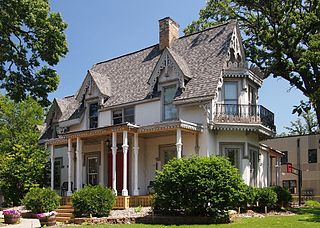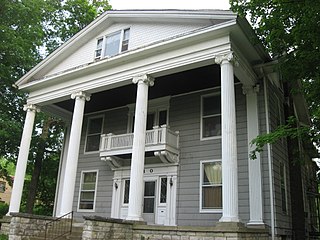While the traditional social fraternity is a well-established mainstay across the United States at institutions of higher learning, alternatives – in the form of social fraternities that require doctrinal and behavioral conformity to the Christian faith – developed in the early 20th century. They continue to grow in size and popularity.

Phi Sigma Phi,(ΦΣΦ) is a national fraternity in the United States founded on July 30, 1988 in South Bend, Indiana by chapters formerly of Phi Sigma Epsilon that declined to participate in that fraternity's merger into Phi Sigma Kappa. There are currently 5 active chapters and one active colony of Phi Sigma Phi nationwide. The current National President is University of Wisconsin-Stevens Point Alumn Joshua Finch.
Welch Hall is a historic residence located at 24 E Stewart Rd on Oak Hill in Columbia, Missouri. The residence is home to the University of Missouri chapter of Sigma Alpha Epsilon. The site was recognized by the Columbia Historic Preservation Commission as one of the city's Most Notable Historic Properties in 2004. It was nominated for the National Register of Historic Places in 2014.

Sigma Phi Epsilon (ΣΦΕ), commonly known as SigEp, is a social college fraternity for male college students in the United States. It was founded on November 1, 1901, at Richmond College, which is now the University of Richmond, and its national headquarters remains in Richmond, Virginia. It was founded on three principles: Virtue, Diligence, and Brotherly Love. Sigma Phi Epsilon is one of the largest social fraternities in the United States in terms of current undergraduate membership.
Samuel M. Plato (1882–1957) was an American architect and building contractor who is noted for his work on federal housing projects and U.S. post offices, as well as designing and building other structures in the United States such as private homes, banks, churches, and schools. During World War II, the Alabama native was one of the few African-American contractors in the country to be awarded wartime building contracts, which included Wake and Midway Halls. He also received contracts to build at least thirty-eight U.S. post offices across the country.

Lockerbie Square Historic District is a national historic district on the National Register of Historic Places within Indianapolis, Indiana, listed on February 23, 1973, with a boundary increase on July 28, 1987. It is noted for its Federal, Italianate, and Queen Anne style architecture. The original platting of Lockerbie Square, done by Jannett Smith Lockerbie McOuat and named for her father, Scottish immigrant George Murray Lockerbie, was between 1847 and 1850. The 1960s saw an immense effort to save the buildings within the district, becoming the first historic district in Indianapolis. Many of the buildings date from 1855 to 1930. James Whitcomb Riley, famed Hoosier poet, lived in the district for over two decades. He was known to give candy to local children on his regular walks.

Old Northside is a residential neighborhood near downtown in Indianapolis, Indiana. It is bordered by 16th Street on the north, Pennsylvania Street on the west, Interstate I-65 on the south, and Bellefontaine Street on the east. The Monon Trail runs along the eastern edge of The Frank and Judy O'Bannon Old Northside Soccer Park.

The B.O. Cutter House is a house in the Marcy-Holmes neighborhood of Minneapolis, Minnesota, United States. It was built in 1856 by master carpenter B.O. Cutter, who was working on other buildings around the University of Minnesota. He built this house on the outskirts of the campus at the time. The house was built in the Carpenter Gothic style with hand-carved molding around the eaves. In 1869, he sold the house to John Gilfillan, who was an educator, regent of the University of Minnesota, banker, attorney, and a U.S. representative in the 49th United States Congress.

The Walnut Park Historic District is located in the University Hill neighborhood of Syracuse, New York, adjacent to the Syracuse University campus. The district was added to the National Register of Historic Places in 1983.

Muncie's Masonic Temple is a historic fraternal lodge building located in Muncie, Indiana. The building is now only used by the Cornerstone Center for the Arts. The Muncie Masonic Temple is in the Gothic Revival style, and was designed and built during the height of the City Beautiful Movement.

The University Courts Historic District is a historic district and neighborhood in Bloomington, Indiana, United States.

Nu Sigma Nu (ΝΣΝ) was an international professional fraternity for medicine, now existing as a handful of stable remaining chapters. It was founded on 2 March 1882 by five medical students at the University of Michigan, who identified as their immediate object "to further the best interests of our profession." Later, its purpose was more fully stated as, "To promote scholarship, the development of better teaching, and generally in raising medical education to a higher level." As one of the earliest formed among all professional fraternities, Nu Sigma Nu was the first fraternal organization nationally to limit membership to medical students only. It can therefore claim that it was the first Medical Professional Fraternity.

The Delta Kappa Epsilon Fraternity House was a historic fraternity house located at the University of Illinois at Urbana–Champaign in Champaign, Illinois.

Eastern Enlargement Historic District is a national historic district located at Greencastle, Putnam County, Indiana. The district encompasses 272 contributing buildings in a predominantly residential section of Greencastle. The district developed between about 1840 and 1961 and includes notable examples of Greek Revival, Gothic Revival, Italianate, Queen Anne, Stick Style, and Bungalow / American Craftsman style architecture. Located in the district are the separately listed Delta Kappa Epsilon Fraternity, F.P. Nelson House and William C. Van Arsdel House. Other notable buildings include the Braman House (1840), James B. Nelson House, O'Hair House, John Ireland House, and a number of fraternity and sorority houses associated with DePauw University.

Delta Kappa Epsilon Fraternity House is a historic Delta Kappa Epsilon fraternity house located at Greencastle, Putnam County, Indiana. It was designed by noted Indiana architect Robert Frost Daggett and built in 1926.

John W. Boehne House, also known as the Tau Kappa Epsilon Fraternity House, is a historic home located at Evansville, Indiana. It was designed by the architecture firm Clifford Shopbell & Co. and built in 1912. It is a 2+1⁄2-story, Colonial Revival style stone sheathed dwelling. It features a monumental front pedimented portico. It was originally built for Congressman John W. Boehne (1856-1946) and has housed the Tau Kappa Epsilon since 1965. Tau Kappa Epsilon is no longer housed on the premises.

Iowa Beta Chapter of Sigma Phi Epsilon is a historic building in Ames, Iowa, United States.

The Sigma Alpha Epsilon Fraternity House is a historic fraternity house in Moscow, Idaho. It was built in 1932 for the Idaho Alpha chapter of Sigma Alpha Epsilon at the University of Idaho. The house was designed by architect Charles I. Carpenter in the Colonial Revival style. It has been listed on the National Register of Historic Places since December 31, 1993.



















